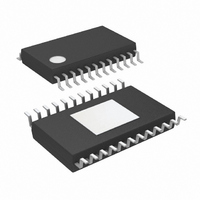LTC3862HFE#PBF Linear Technology, LTC3862HFE#PBF Datasheet - Page 16

LTC3862HFE#PBF
Manufacturer Part Number
LTC3862HFE#PBF
Description
IC CTRLR DC/DC MULTI-PH 24TSSOP
Manufacturer
Linear Technology
Type
Step-Up (Boost)r
Datasheet
1.LTC3862EGNPBF.pdf
(40 pages)
Specifications of LTC3862HFE#PBF
Internal Switch(s)
No
Synchronous Rectifier
No
Number Of Outputs
1
Voltage - Output
1.22 ~ 200 V
Current - Output
50mA
Frequency - Switching
300kHz
Voltage - Input
4 ~ 36 V
Operating Temperature
-40°C ~ 150°C
Mounting Type
Surface Mount
Package / Case
24-TSSOP Exposed Pad, 24-eTSSOP, 24-HTSSOP
Lead Free Status / RoHS Status
Lead free / RoHS Compliant
Power - Output
-
LTC3862
Operation of the RUN Pin
The control circuitry in the LTC3862 is turned on and
off using the RUN pin. Pulling the RUN pin below 1.22V
forces shutdown mode and releasing it allows a 0.5μA
current source to pull this pin up, allowing a “normally
on” converter to be designed. Alternatively, the RUN pin
can be externally pulled up or driven directly by logic.
Care must be taken not to exceed the absolute maximum
rating of 8V for this pin.
The comparator on the RUN pin can also be used to sense
the input voltage, allowing an undervoltage detection
circuit to be designed. This is helpful in boost converter
applications where the input current can reach very high
levels at low input voltage:
The 1.22V input threshold of the RUN comparator is derived
from a precise bandgap reference, in order to maximize
the accuracy of the undervoltage-sensing function. The
RUN comparator has 80mV built-in hysteresis. When
the voltage on the RUN pin exceeds 1.22V, the current
sourced into the RUN pin is switched from 0.5μA to 5μA
PTAT current. The user can therefore program both the
rising threshold and the amount of hysteresis using the
values of the resistors in the external divider, as shown in
the following equations:
Several of the possible RUN pin control techniques are
illustrated in Figure 5.
Frequency Selection and the Phase Lock Loop
The selection of the switching frequency is a tradeoff
between effi ciency and component size. Low frequency
operation increases effi ciency by reducing MOSFET
switching losses, but requires a larger inductor and output
capacitor to maintain low output ripple.
OPERATION
16
I
V
V
IN
IN ON
IN OFF
=
(
(
I
OUT
)
)
V
=
=
IN
1 22
•
1. .
.
• η
V
22
OUT
V
V
⎛
⎝ ⎜
⎛
⎝ ⎜
1
1
+
+
R
R
R
R
B
A
B
A
⎞
⎠ ⎟
⎞
⎠ ⎟
– .
–
0 5
5
μ R
μ R
•
•
A
A
Figure 5c. Programming the Input Voltage Turn-On and Turn-Off
Thresholds Using the RUN Pin
Figure 5a. Using the RUN Pin for a “Normally On” Converter
EXTERNAL
CONTROL
LOGIC
R
R
Figure 5b. On/Off Control Using External Logic
A
B
0.5μA
0.5μA
V
RUN
SGND
10V
V
RUN
SGND
0.5μA
10V
IN
IN
V
RUN
SGND
INTERNAL 5V
10V
INTERNAL 5V
IN
INTERNAL 5V
1.22V
1.22V
4.5μA
1.22V
4.5μA
4.5μA
+
–
–
+
+
–
RUN
COMPARATOR
RUN
COMPARATOR
RUN
COMPARATOR
BIAS AND
START-UP
CONTROL
BIAS AND
START-UP
CONTROL
START-UP
CONTROL
BIAS AND
LTC3862
LTC3862
LTC3862
3862 F05a
3862 F05c
3862 F05b
3862fb












